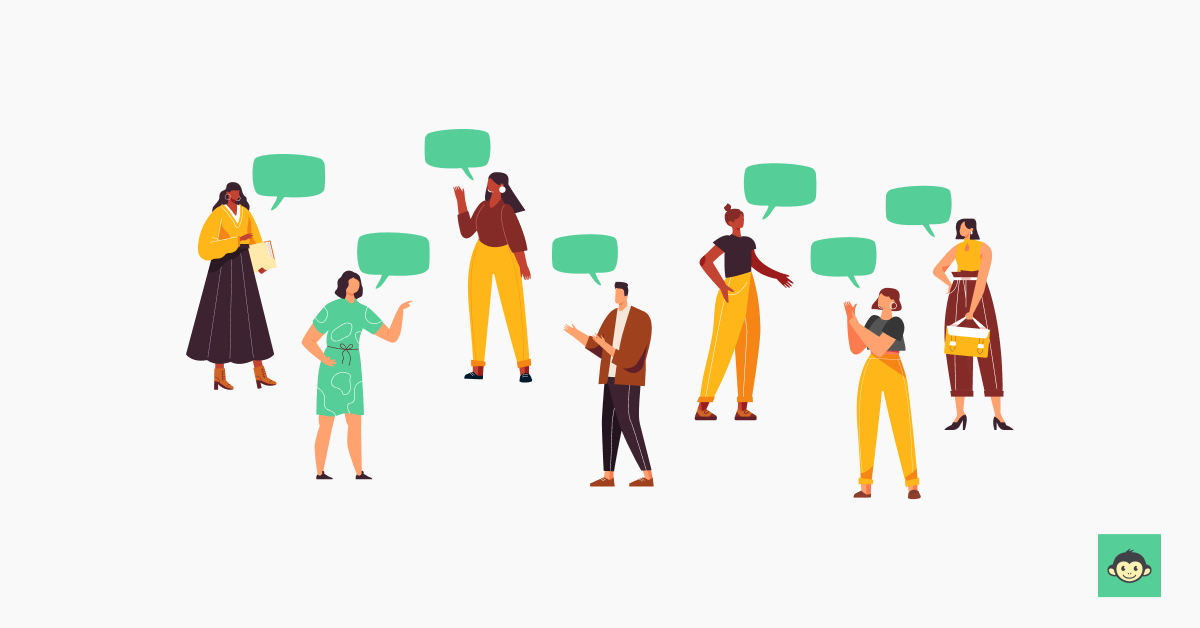What are cultural differences in the workplace: Top 9 strategies to promote DEI in 2024

Have you ever encountered a situation at work where a misunderstanding arose due to differing backgrounds or communication styles? This is likely a result of cultural differences in the workplace.
Cultural diversity encompasses a variety of factors that influence how people work, from ethnicity, sexual orientation, and religion to communication styles and work ethic. While it can sometimes lead to challenges, a diverse workplace offers a wealth of benefits.
This blog post will delve into the world of cultural differences in the workplace. We'll explore what it means to have a culturally diverse team and the potential challenges that can arise.
But don't worry, this isn't all negative! We'll also provide valuable strategies and tips to help you navigate these differences and create a truly diverse workforce and an inclusive work environment.
By fostering an appreciation for workplace diversity, you can unlock the full potential of your team and create a more successful and enriching work experience for everyone.
Cultural differences in the workplace: definition
Cultural differences in the workplace refer to the variations in norms, values, behaviors, and communication styles among individuals from different cultural backgrounds within an organizational setting.
These differences can stem from a variety of factors including nationality, ethnicity, religion, language, and socio-economic background. Understanding and managing cultural diversity in the workplace is essential for fostering inclusivity, promoting collaboration, and maximizing productivity.
One key aspect of cultural differences in the workplace is communication styles. Different cultures may have distinct preferences for directness, assertiveness, and hierarchy in communication.
Cultural diversity also influences management practices and organizational structures. Leaders must adapt their management styles to accommodate diverse cultural expectations and preferences.
This may involve recognizing and valuing different perspectives, promoting cultural sensitivity and awareness, and implementing policies and practices that accommodate diverse needs.
Why is it important to understand cultural differences in the workplace as a leader?

Understanding cultural differences in the workplace is crucial for leaders for several reasons. Let’s take a look at them.
- Effective communication: Leaders must be able to communicate effectively with employees from diverse cultural backgrounds. Understanding differences in communication styles, such as directness, assertiveness, and non-verbal cues, allows leaders to convey messages clearly and avoid misunderstandings.
- Building trust and relationships: Cultural awareness enables leaders to build trust and rapport with employees from different cultural backgrounds. By recognizing and respecting cultural norms, values, and perspectives, leaders can foster an inclusive and supportive work environment where employees feel valued and understood.
- Conflict resolution: Cultural differences can sometimes lead to misunderstandings and conflicts in the workplace. Leaders who understand cultural differences are better equipped to address and resolve conflicts by mediating disagreements, promoting empathy, and facilitating open dialogue among team members.
- Maximizing team performance: Diverse teams often bring a variety of perspectives, ideas, and approaches to problem-solving. Leaders who understand cultural differences can leverage the strengths of their team members and create an environment that encourages collaboration, innovation, and creativity.
- Enhancing global competence: In today's globalized world, many organizations operate across borders and have diverse workforces. Leaders who understand cultural differences are better prepared to navigate cross-cultural interactions, negotiate with international partners, and adapt their strategies to different cultural contexts.
- Avoiding legal and ethical pitfalls: Cultural insensitivity or ignorance can lead to legal and ethical issues in the workplace, such as discrimination, harassment, or unfair treatment. Leaders who are culturally competent can ensure that their actions and decisions align with legal requirements and ethical standards, promoting fairness and equity for all employees.
Types of cultural differences in the workplace

Understanding and navigating the following cultural differences is essential for creating a harmonious and inclusive work environment.
- Communication styles: Different cultures may have varying preferences for communication styles, such as directness, assertiveness, and non-verbal cues. For example, some cultures value explicit and straightforward communication, while others may use indirect or nuanced language to convey messages.
- Work ethic and attitudes toward authority: Cultural backgrounds influence attitudes towards work, including concepts of punctuality, diligence, and hierarchy. Some cultures may prioritize individual initiative and autonomy, while others may emphasize respect for authority and hierarchical structures.
- Time orientation: Cultures may differ in their approach to time management and scheduling. Some cultures prioritize punctuality and adherence to deadlines, while others may have a more relaxed attitude toward time and prioritize flexibility and adaptability.
- Decision-making processes: Cultural differences influence decision-making styles, including approaches to consensus-building, risk-taking, and problem-solving. Some cultures may prefer hierarchical decision-making, with authority concentrated at the top, while others may value participatory decision-making and consensus-building among team members.
- Conflict resolution: Cultural norms and values shape attitudes towards conflict and methods for resolving disagreements. Some cultures may prefer direct confrontation and assertiveness in conflict resolution, while others may prioritize harmony and avoid confrontation.
- Leadership and management styles: Cultural differences impact leadership and management practices, including approaches to motivation, delegation, and feedback. Leadership styles may vary based on cultural preferences for hierarchy, collectivism versus individualism, and communication styles.
- Attitudes towards diversity and inclusion: Cultural backgrounds influence attitudes towards diversity, equity, and inclusion in the workplace. Some cultures may value diversity and actively promote inclusivity, while others may be more homogeneous and less receptive to diversity initiatives.
Benefits of cultural differences in the workplace

Embracing cultural differences in the workplace not only promotes diversity and inclusion and helps build a culturally diverse workplace, but also brings several other benefits. Let’s take a look at them.
Increased creativity and innovation
Diverse perspectives stemming from cultural differences can lead to innovative ideas and solutions to complex problems. Employees from different backgrounds and cultural backgrounds may approach challenges with unique insights and experiences, fostering creativity and innovation within teams.
Enhanced problem-solving abilities
Cultural diversity encourages individuals to consider a wider range of perspectives when problem-solving. By drawing on diverse cultural experiences and approaches, teams can identify novel solutions and adapt more effectively to changing circumstances.
Expanded market reach
Cultural diversity in the workforce enables organizations to better understand and connect with diverse customer segments. Employees from various cultural backgrounds can provide valuable insights into the preferences, needs, and behaviors of different consumer groups, facilitating market expansion and growth.
Improved decision-making
Diversity of thought resulting from cultural differences can lead to more robust decision-making processes. When teams incorporate diverse perspectives, they are more likely to consider a broader range of factors and anticipate potential risks, leading to more informed and effective decisions.
Enhanced employee engagement and retention
Culturally diverse companies and workplaces that prioritize inclusion and respect for all employees tend to have higher levels of employee engagement and satisfaction.
When employees feel valued and respected for their unique backgrounds and perspectives, they are more likely to be committed to their work and remain with the organization long-term.
Expanded talent pool
Embracing cultural diversity allows organizations to tap into a wider talent pool, attracting top talent from diverse backgrounds. By fostering an inclusive workplace culture that values diversity, organizations can attract and retain a culturally diverse workforce with a range of skills, experiences, and perspectives.
Global competitiveness
In an increasingly interconnected world, cultural diversity gives organizations a competitive edge in global markets.
Companies with culturally diverse teams are better equipped to navigate cross-cultural interactions in the business world, understand local market dynamics, and adapt their products and services to diverse customer needs and preferences.
Top challenges of cultural differences in the workplace

Addressing the following challenges requires proactive efforts to promote cultural awareness, foster an inclusive culture of communication, mitigate biases, and build cross-cultural competence among leaders and employees.
- Communication barriers: Differences in language proficiency, communication styles, and non-verbal cues can lead to misunderstandings and ineffective communication among team members. Language barriers, in particular, can hinder collaboration and information sharing, impacting productivity and teamwork.
- Bias and stereotypes: Unconscious biases and stereotypes based on cultural differences can influence decision-making, performance evaluations, and interactions in the workplace. Preconceived notions about certain cultural groups may lead to unfair treatment, discrimination, and exclusion, undermining morale and trust among employees.
- Resistance to change: Introducing new ideas, processes, or initiatives may face resistance from employees who are accustomed to different cultural norms and practices. Cultural resistance to change can hinder innovation, hinder organizational agility, and impede efforts to adapt to evolving market conditions.
- Ingroup-outgroup dynamics: Cultural differences can contribute to the formation of ingroups and outgroups within teams, leading to cliques, favoritism, and exclusionary behaviors. These dynamics can undermine collaboration, trust, and cohesion among team members, affecting morale and productivity.
How do you deal with cultural differences in the workplace: 9 Top strategies that work

Here are nine effective strategies for dealing with cultural differences in the workplace. By implementing these strategies, organizations can create a workplace culture that values cultural diversity important enough, fosters inclusivity, and maximizes the benefits of cultural differences.
1. Cultural awareness training
Provide cultural awareness training for employees to increase understanding and appreciation of different cultural norms, values, and communication styles. This training can help mitigate misunderstandings and promote empathy and mutual respect among team members.
2. Encourage open communication
Foster an inclusive environment where employees feel comfortable discussing cultural differences and sharing their perspectives. Encourage open dialogue and active listening to facilitate mutual understanding and appreciation of diverse viewpoints.
3. Establish clear communication norms
Establish clear communication norms and guidelines to accommodate diverse communication styles and preferences. Provide clarity on expectations for language use, directness, and feedback delivery to minimize misunderstandings and promote effective communication.
4. Promote inclusive leadership
Train leaders to be culturally competent and inclusive in their leadership approach. Encourage leaders to lead by example, demonstrate respect for cultural differences, promote cultural diversity, and create opportunities for all team members to contribute and succeed.
5. Create multicultural teams
Form multicultural teams that bring together individuals from diverse cultural backgrounds to work collaboratively on projects. Encourage team members to leverage their diversity to bring unique perspectives and experiences to drive innovation and problem-solving.
6. Facilitate cross-cultural training
Offer cross-cultural training programs that provide practical skills and strategies for navigating cross-cultural interactions in the workplace. Topics may include cultural etiquette, conflict resolution, and building cross-cultural relationships.
7. Promote flexibility and adaptability
Encourage flexibility and adaptability in work practices to accommodate diverse cultural preferences and needs. Be open to alternative approaches to work processes, scheduling, and decision-making to foster inclusivity, promoting diversity and respect for cultural differences.
8. Provide resources and support
Offer resources and support systems to assist employees in navigating cultural differences and overcoming challenges. This may include access to cultural sensitivity resources, language interpretation services, and employee support networks.
9. Regularly assess and adjust
Continuously assess the effectiveness of strategies for managing cultural differences in the workplace and make adjustments as needed. Solicit feedback from diverse employees, monitor cultural dynamics within teams, and refine policies and practices to promote inclusivity and harmony.
Role of DEI surveys in managing cultural differences in the workplace

DEI (Diversity, Equity, and Inclusion) surveys play a crucial role in managing cultural differences in the workplace by providing valuable insights into the experiences, perspectives, and needs of employees from diverse backgrounds.
These surveys serve as a tool for organizations to assess the current state of diversity and inclusion within their workforce and identify areas for improvement.
By gathering data on factors such as representation, inclusion, bias, and workplace culture, DEI surveys help organizations understand the specific challenges and barriers faced by employees from different cultural backgrounds. Moreover, DEI surveys provide employees with a platform to voice their opinions and concerns anonymously, creating a safe space for honest feedback.
This feedback allows organizations to identify systemic issues related to cultural differences, such as discrimination, microaggressions, or unequal opportunities, and take proactive measures to address them.
Significance of DEI software to measure and improve diversity in the workplace
A DEI (Diversity, Equity, and Inclusion) software such as CultureMonkey serves as a pivotal tool in measuring and enhancing diversity within the workplace. These software solutions offer a comprehensive platform for organizations to collect, analyze, and manage data related to diversity metrics, employee demographics, and inclusion initiatives.
By centralizing this data, organizations gain valuable insights into the current state of diversity within their workforce, allowing them to identify areas for improvement and develop targeted strategies to address disparities and promote inclusivity.
One significant aspect of DEI software is its ability to track progress and measure the impact of diversity and inclusion initiatives over time. By setting benchmarks and monitoring key metrics, organizations can gauge the effectiveness of their efforts and hold themselves accountable for making meaningful progress towards diversity goals.
This data-driven approach enables organizations to identify trends, assess the success of specific interventions, and adjust strategies as needed to drive continuous improvement.
DEI software plays a crucial role in promoting transparency and communication around diversity and inclusion efforts within the organization. By sharing diversity data, progress reports, and action plans with employees, stakeholders, and external partners, organizations demonstrate their commitment to fostering a diverse and inclusive workplace culture.
This transparency fosters trust, accountability, and engagement among employees, reinforcing the organization's dedication to creating a more equitable and supportive work environment for all.
Conclusion
DEI software serves as a critical tool for organizations striving to foster diversity, equity, and inclusion in the workplace.
By providing data-driven insights, facilitating accountability, promoting transparency, and supporting inclusive practices, DEI software empowers organizations to build diverse, equitable, and inclusive workplace cultures where all employees feel valued, respected, and empowered to thrive.
Through the effective use of DEI software, organizations can not only measure and manage diversity but also drive meaningful progress toward building a more equitable and diverse culture and supportive work environment for everyone.



